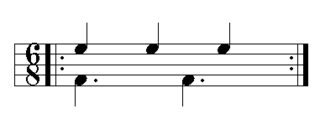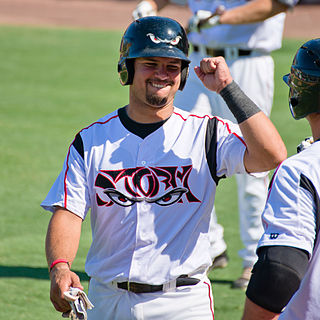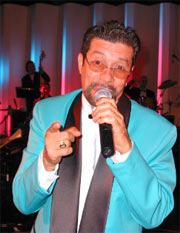Related Research Articles
Mambo is a genre of Cuban dance music pioneered by the charanga Arcaño y sus Maravillas in the late 1930s and later popularized in the big band style by Pérez Prado. It originated as a syncopated form of the danzón, known as danzón-mambo, with a final, improvised section, which incorporated the guajeos typical of son cubano. These guajeos became the essence of the genre when it was played by big bands, which did not perform the traditional sections of the danzón and instead leaned towards swing and jazz. By the late 1940s and early 1950s, mambo had become a "dance craze" in Mexico and the United States as its associated dance took over the East Coast thanks to Pérez Prado, Tito Puente, Tito Rodríguez and others. In the mid-1950s, a slower ballroom style, also derived from the danzón, cha-cha-cha, replaced mambo as the most popular dance genre in North America. Nonetheless, mambo continued to enjoy some degree of popularity into the 1960s and new derivative styles appeared, such as dengue; by the 1970s it had been largely incorporated into salsa.
The music of Cuba, including its instruments, performance, and dance, comprises a large set of unique traditions influenced mostly by west African and European music. Due to the syncretic nature of most of its genres, Cuban music is often considered one of the richest and most influential regional music in the world. For instance, the son cubano merges an adapted Spanish guitar (tres), melody, harmony, and lyrical traditions with Afro-Cuban percussion and rhythms. Almost nothing remains of the original native traditions, since the native population was exterminated in the 16th century.

Hialeah-Miami Lakes Senior High School is a public high school operated by Miami-Dade County Public Schools, located at 7977 West Twelfth Avenue in Hialeah, Florida, United States, on the boundary with the city of Miami Lakes.

Criolla is a genre of Cuban music which is closely related to the music of the Cuban Coros de Clave and a genre of Cuban popular music called Clave.

Fredi Jesús González is a Cuban-born American baseball coach and manager who is currently the bench coach for the Baltimore Orioles. He managed the Florida Marlins from 2007 to 2010 and the Atlanta Braves from 2011 to 2016. González was fired from both managing positions. For four seasons prior to 2007, he was the third base coach for the Atlanta Braves. Despite never reaching the playoffs with Florida, González nearly led the Braves to a playoff berth in his first season as manager in 2011. He then guided the Braves to the postseason in 2012 and 2013.
Cuban folk music includes a variety of traditional folk music of Cuba, and has been influenced by the Spanish and the African culture as well as the remaining indigenous population of the Caribbean.
The National Symphony Orchestra of Cuba is the main institution dedicated to the performance of classical music in Cuba
Santiago Rodriguez is a Cuban-American pianist. Rodriguez is an exclusive recording artist for Élan Recordings. His Rachmaninov recordings received the Rosette award in The Penguin Guide to Recorded Classical Music and he is a silver medalist in the Van Cliburn International Piano Competition.

PUNTO Experimental Music Ensemble is a contemporary music group active in Miami, Florida, United States.

Gustavo Matamoros is a Venezuelan composer, interdisciplinary artist, community organizer and educator who has established his residence in Miami, Florida, US, since 1979.

Eddy Rodríguez is a Cuban-American professional baseball former catcher and coach. He was the catching coach for the Miami Marlins of Major League Baseball (MLB) from 2020 to 2022. He played in MLB for the San Diego Padres.
The guitar was the first instrument that was heard in Cuba after the conch horns, flutes and drums that the original aborigines used to play; as it was documented by Spanish chroniclers such as Bernal Díaz del Castillo. Through the centuries, the guitar has continued to be one of the most important and cherished instruments in Cuba, both in the practice of popular music as well as in the classical music tradition. Founded by renowned professors such as Clara Romero, Isaac Nicola, Clara (Cuqui) Nicola, Carlos Molina, and Marta Cuervo Riverón, the Cuban guitar school has acquired an excellent international reputation since the 20th century, represented by important instrumentalists and composers such as Leo Brouwer, Carlos Molina, José Rey de la Torre, Juan Antonio Mercadal and Joaquín Clerch, among many others.
Carlos Molina is a Cuban guitarist and professor.
Miguel Bonachea is a Cuban guitarist and professor.

Israel Kantor, also known as Israel Sardinas, Wilfredo Israel Sardinas, and Wilfredo Israel Sardiñas Domínguez, was a Cuban-born musician and composer who later lived and worked in the United States. Born 1949 in a town called Alturas de Canasi with the name Wilfredo Israel Sardinas, he grew up in Havana, Cuba. He gained popularity in the 1970s as a sonero, a singer of the Son cubano style of music. Early influences included music by Beny More. He joined with Los Van Van in 1980 and toured globally with them, before leaving the group and moving to the United States in 1983.
Galician rumba belongs to those songs and dances called cantes de ida y vuelta, "of departure and return", like the Habanera, that travelled back from Cuba to the Spanish motherland to establish themselves as musical genres cultivated and cherished by the Spanish population.
Puchito Records was Cuba's second independent record label. It was founded in 1954 during the mambo and cha-cha-chá explosion. Many of its recordings, produced by its founder Jesús Gorís, became instant hits.
Alfredo Martinez is a Cuban-American art collector, fine art photographer, curator, dealer, promoter, author, and former gallerist. He became a prominent figure in the Latin American fine art market internationally and particularly in South Florida after he began organizing art exhibitions in the mid-1980s. Martinez's professional and philanthropic art events and patronage activities were distinctive for referencing contemporary social issues, such as AIDS and underrepresented cultures in the arts. Martinez owned and operated two major art galleries and other art-related businesses based in Coral Gables, Florida. He has organized art exhibitions, lectures, and auctions throughout the United States and Latin America, including South Florida, New Hampshire, Argentina, Panama, and Costa Rica.
Pedro Hernandez Dominguez is a Cuban American artist primarily known for his sculptures in wood and stone as well as paper medium works. Since beginning his art career in the 1950s, he has been primarily active in Cuba, the United States, and Europe. He is among the significant contributing artists to the establishment of Cuban art in South Florida during the 20th century. His artwork has gained recognition for his awards, use in public art, coverage in media and published Cuban art literature, as well as international exhibitions. Hernandez is included in the permanent collection of the Museo Nacional de Bellas Artes de La Habana, the Museum of Geometric and MADI Art, the City of Hialeah, and the Miami-Dade Public Library System.
